|
< Earlier Kibitzing · PAGE 2 OF 2 ·
Later Kibitzing> |
| Oct-20-14 | | estrick: I think all these queen sac puzzles not only make Mondays too predictable, they also make me lazy and help to instill a lazy habit . . . |
|
| Oct-20-14 | | greed and death: This was too easy, so I had White helpmate himself from the puzzle position. 28. Qh4 Nxh4 29. Rg1 Qxf5 30. Rg5 Qf1+ 31. Rg1 Rxg1# |
|
| Oct-20-14 | | agb2002: White has a bishop and a pawn.
White would deliver mate at once if the pawn on h7 disappeared. Hence, 28.Qxh7+ Kxh7 29.Rh5#. |
|
| Oct-20-14 | | morfishine: 28.Qxh7+ Kxh7 29.Rh5# |
|
| Oct-20-14 | | Once: As usual, the challenge for a Monday is to find something that hasn't already been said. So let's rewind a couple of moves to the position after 26...Rg8 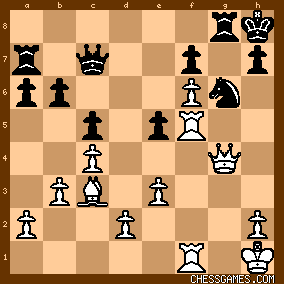
click for larger viewIt is white to play and apply a little bit of psychology. The key weakness in the position is the h7 pawn. White has two different ways of targeting it - rook first or queen first. The rook first method is Qh3 and Rh5, pointing a BFG at the h7 pawn. That's a "big flipping gun" for those who don't know classic computer games. The queen first method is the game line - Qh3 or Qh5, threatening a queen sac on h7 followed by Rh5#. That's not a gun. As Obi Wan might have said, it's an elegant weapon for a more civilized age. So the question has to be ... do we play 27. Qh3 or 27. Qh5? Fritzie can't tell them apart. After ten minutes on my wheezing laptop he has 27. Qh3 at +3.42 and 27. Qh5 at +3.41. And I do not trust his Germanic magnificence to be accurate to within one hundredth of a prawn. But I think most humans would play 27. Qh3 for two reasons. First, it gives white the option of either "rook first" or "queen first". From h3 the queen doesn't block Rh5. White can opt for either plan, depending on how black plays. 27. Qh3 also contains a little trap. By making room for Rh5, white gives a broad hint that the plan is "rook first". So instead of blocking both with 27...Nf8, black is tricked into looking for a defence to 28. Rh5. And that explains 27. Qh3 Qd7? 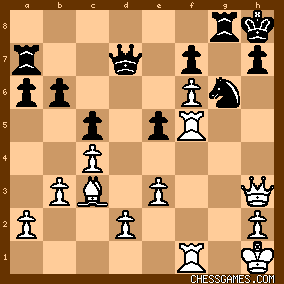
click for larger viewWith 27...Qd7 Black pins the Rf5, hoping for 28. Rh5 Qxh3 and the white attack looks a lot less scary. But that idea does nothing to stop 28. Qxh7+ followed by Rh5#. If white had played 27. Qh5 instead of Qh3, it is possible that black may have spotted the Qxh7+ tactic and defended against it. White should still win, but not as quickly. Computers don't yet understand this. Sometimes the best move in a real game is not the strongest, but the one that tricks our opponent into playing a weak move. Or possibly gives him too much to think about that he misses something. |
|
| Oct-20-14 | | onesax: <greed and death> There's a faster helpmate I can see: 28. Kg2! Nh4+ 29. Kf2 any 30. Ba1 Qxd2# |
|
| Oct-20-14 | | stacase: That took about ten seconds. |
|
| Oct-20-14 | | cocker: Black's rook and knight are complicit in the execution. |
|
| Oct-20-14 | | gofer: <Once>: Is there nothing more to say about this position (after <24 gxf6 ...>)?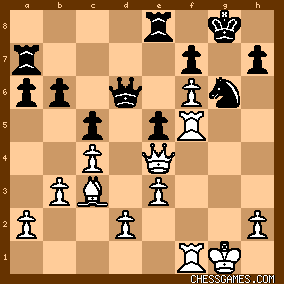
click for larger viewSurely the writing is one the wall! It is going to take
black four moves to extricate its king from the grave of
g8 (because playing Kh8 and Rg8 is a horrible way to
relieve pressure on a boxed in king!) and Ng6 is stuck where it is, Pe5 is lost, black has absolutely no attack, where as white can easily and simply bring pressure on Ph7 with three different pieces... What does <Fritz> say of black's chances at this point? Doesn't black have to play 24 ... Re6 and hope to run the king to d7 (or play Qf8 if white attention shifts to Ph7 - which it going to do!!!)? In any case, surely its almost resignation time... |
|
| Oct-20-14 | | zb2cr: 28. Qxh7+, Kxh7; 29. Rh5#. Simple, yet satisfying.... |
|
| Oct-20-14 | | Once: <gofer> Fritz has black losing for some moves earlier than 24. gxf6. The rot seems to start around move 12 after white plays 12. g4 threatening g5 to kick the Nf6. 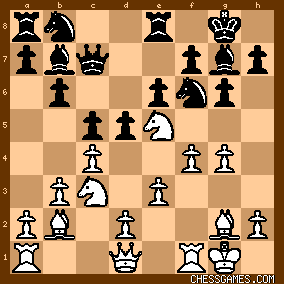
click for larger viewInstead of 12...a6 (preparing for a b5 push that never comes), Fritzie wants to play 12...Ne4. The game goes steadily downhill from there. By the time we get to 16. e5, we're at +1.6. 17...gxf5 pushes it up to +2
Fritzie doesn't like the plan of Nf8-Ng6 - the evals get to +2.5. Instead Qc6 or Rd8 were better (but still losing). By the time we get to 22. Raf1 Ra7, white has a choice of moves scoring more than +2.5. He is a pawn up and has a lot more space, but there is no obvious mate looming. After 24. gxf6, Fritz has a choice of moves which evaluate at around +3. He wants to build a fortress with Kh8-Rg8-Nf8. But then he loses his e5 pawn and white wins on material. Black may be able to avoid a quick mate, but the outcome of the game doesn't seem in doubt. |
|
| Oct-20-14 | | patzer2: <Once:...Sometimes the best move in a real game is not the strongest, but the one that tricks our opponent into playing a weak move.> As a general rule, I'd disagree with that statement and argue that making less than the best moves to trick an opponent is a not a good idea. It's particularly bad for novice players, who tend to make weak threatening moves which are easily refuted and more often than not result in a positional disadvantage. Case in point is the Scholar's Mate attempt 1. e4 e5 2.Qh5?! Nc6 3. Bc4, which hopes for 3...Nf6?? 4. Qxf7# but throws away the White opening advantage after 3...g6 4. Qf3?! (4. Qd1!? = to  ) 4...Nf6 ) 4...Nf6  . . However in this particular case of choosing between 27. Qh5!  and 27. Qh3! and 27. Qh3!  , you have a point. Both moves win decisively after best play of 27...Qc6+ 28. R1f3 Nf8 29. Rxe5 , you have a point. Both moves win decisively after best play of 27...Qc6+ 28. R1f3 Nf8 29. Rxe5  . . Given a choice between two clear winning moves, I suppose there's no harm done in picking the one that could provoke a weak move and result in a quick mate. |
|
Oct-20-14
 | | Penguincw: Hehe. I correctly predicted the puzzle. :)
Just kidding, I saw it on <cg>'s Facebook. :) |
|
| Oct-20-14 | | patzer2: <Once> Agree with your analysis of 12...Ne5! = instead of 12...a6?. If 12...Ne5! 13. Nxe5 dxe5 14. Qc2?? (diagram below)
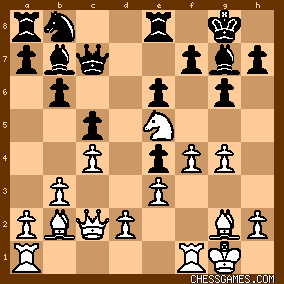
click for larger viewWhite drops a piece to 14...f6!  . .
The best try after 12...Ne5! 13. Nxe5 dxe5 is probably 14. g5, which gives Black the extra tempo to play 14...Nd7 = to  (diagram below) (diagram below) 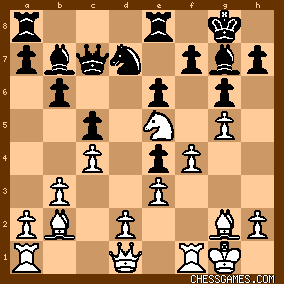
click for larger viewwith even or better chances. |
|
| Oct-20-14 | | patzer2: Since it's Monday and we're looking at an easy mate in this game, and the strong moves leading up to it. I thought I'd share a strong move leading to an unusual mate-in-one from some computer analysis of this game. Looking at the try 15...f6 (instead of 15...Nd7), I played Black against Fritz toward the end of the continuation 15... f6 16. gxf6 Bxf6 17. Bxe4 Nc6 18. Ng4 Bg7 19. a3 Rf8 20. Rab1 a5 21. Bxg7 Qxg7 22. Rf3 Rad8 23. Rd1 Rd6 24. Rdf1 Rfd8 25. d3 R8d7 26. Rh3 Rd8 27. Rg3 Kh8 28. Qg2 Ba8 29. h4 Rg8 30. Kh1 Qf8 31. Ne5 Qe8 32. Bxc6 Bxc6 33. e4 Qf8 34. h5 gxh5 35. Rxg8+ Qxg8 (diagram below) 
click for larger view36. Qb2!! Qg7 37. Rg1 Qf6 (diagram below)
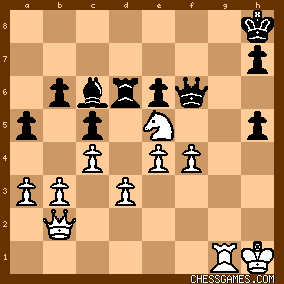
click for larger viewwhen it's mate-in-one on me with 37. Nf7#! |
|
| Oct-20-14 | | YetAnotherAmateur: Notice the division this game was played in. I'm glad to know I can still beat a kid at this game. In this case, with 28. Qxh7+ Kxh7 29. Rxh7# |
|
Oct-20-14
 | | gawain: Amusing finish. Black's knight and rook are useless--nay, very much worse than useless. They occupy the King's escape squares and so permit a mate on the h-file |
|
Oct-20-14
 | | Bubo bubo: Canonical Monday: 28.Qxh7+ Kxh7 29.Rh5# |
|
| Oct-20-14 | | DrGridlock: Black has a stalemate king: almost any check will be lethal.
Hey, here's a check - Qxh7+
Hey, here's another - Rh5+.
One of the rare times that Bobby Fischer's maxim, "patzer sees check, patzer makes check" brings the game to a glorious end! |
|
| Oct-20-14 | | kevin86: A quick mate in two! The Queen Sac is back!!
28 ♕xh7+ ♔xh7 29 ♖h5# |
|
| Oct-20-14 | | Castleinthesky: How about solved in under 5 seconds? Monday, Monday. |
|
| Oct-20-14 | | get Reti: Saw it instantaneously. First, my eyes went to the queen, then to the pawn in front of the king. |
|
| Oct-20-14 | | BOSTER: < estrick: I think all these queen sac puzzles make me lazy>. The real puzzle begins not when you see the POTD pos., but when you ask himself what do I want (expect) from CG, or what can I offer them? |
|
| Oct-20-14 | | JTV: 12...Ne4 is the move for black. Nb5 has no real threats so why bother preventing it with 12...a6? Unless one expects white to lose on the e4 attack! It would go like this 12. g4 Ne4 13. g5 Qe7 14. Nxe4 dxe4 15. Qc2 Nd7 16. Bxe4 Bxe4 17. Qxe4 Nxe5 18. Bxe5 Bxe5 19. Qxe5 Red8 and black has maintained whites slight edge. Let's back up and say after 12...Ne4 white decided to move 13. Nb3, then it's 13...Qe7 14. g5 a3! and now white is at a disadvantage... |
|
| Oct-20-14 | | Charlie Cheswick: <greed and death> Nice helpmate. That would be humbling for the winner. |
|
 |
|
< Earlier Kibitzing · PAGE 2 OF 2 ·
Later Kibitzing> |





































